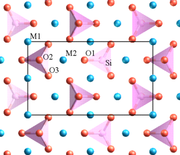
Monticellite
Encyclopedia
Monticellite and kirschsteinite are gray silicate
mineral
s of the olivine group with compositions Ca
Mg
Si
O
4 and CaFe
SiO4, respectively. Most monticellites have the pure magnesium end-member composition but rare ferroan monticellites and magnesio-kirschsteinite are found with between 30 and 75 mol.% of the iron end member. Pure kirschsteinite is only found in synthetic systems. Monticellite is named after Teodoro Monticelli Italian mineralogist (1759–1845).
Like other members of the group monticellite and kirschsteinite have orthorhombic unit cells (space group Pbnm) shown in Figure 1. Iron and magnesium ions are located on the M1 inversion sites and calcium ions occupy the M2 site on mirror planes. The unit cell is somewhat larger than for the calcium free olivines forsterite
and fayalite
with
and for monticellite

Silicate
A silicate is a compound containing a silicon bearing anion. The great majority of silicates are oxides, but hexafluorosilicate and other anions are also included. This article focuses mainly on the Si-O anions. Silicates comprise the majority of the earth's crust, as well as the other...
mineral
Mineral
A mineral is a naturally occurring solid chemical substance formed through biogeochemical processes, having characteristic chemical composition, highly ordered atomic structure, and specific physical properties. By comparison, a rock is an aggregate of minerals and/or mineraloids and does not...
s of the olivine group with compositions Ca
Calcium
Calcium is the chemical element with the symbol Ca and atomic number 20. It has an atomic mass of 40.078 amu. Calcium is a soft gray alkaline earth metal, and is the fifth-most-abundant element by mass in the Earth's crust...
Mg
Magnesium
Magnesium is a chemical element with the symbol Mg, atomic number 12, and common oxidation number +2. It is an alkaline earth metal and the eighth most abundant element in the Earth's crust and ninth in the known universe as a whole...
Si
Silicon
Silicon is a chemical element with the symbol Si and atomic number 14. A tetravalent metalloid, it is less reactive than its chemical analog carbon, the nonmetal directly above it in the periodic table, but more reactive than germanium, the metalloid directly below it in the table...
O
Oxygen
Oxygen is the element with atomic number 8 and represented by the symbol O. Its name derives from the Greek roots ὀξύς and -γενής , because at the time of naming, it was mistakenly thought that all acids required oxygen in their composition...
4 and CaFe
Iron
Iron is a chemical element with the symbol Fe and atomic number 26. It is a metal in the first transition series. It is the most common element forming the planet Earth as a whole, forming much of Earth's outer and inner core. It is the fourth most common element in the Earth's crust...
SiO4, respectively. Most monticellites have the pure magnesium end-member composition but rare ferroan monticellites and magnesio-kirschsteinite are found with between 30 and 75 mol.% of the iron end member. Pure kirschsteinite is only found in synthetic systems. Monticellite is named after Teodoro Monticelli Italian mineralogist (1759–1845).
Like other members of the group monticellite and kirschsteinite have orthorhombic unit cells (space group Pbnm) shown in Figure 1. Iron and magnesium ions are located on the M1 inversion sites and calcium ions occupy the M2 site on mirror planes. The unit cell is somewhat larger than for the calcium free olivines forsterite
Forsterite
Forsterite is the magnesium rich end-member of the olivine solid solution series. Forsterite crystallizes in the orthorhombic system with cell parameters a 4.75 Å , b 10.20 Å and c 5.98 Å .Forsterite is associated with igneous and metamorphic rocks and has also been found in meteorites...
and fayalite
Fayalite
Fayalite is the iron-rich end-member of the olivine solid-solution series. In common with all minerals in the olivine group, fayalite crystallizes in the orthorhombic system with cell parameters a 4.82 Å, b 10.48 Å and c Å 6.09.Iron rich olivine is a relatively common constituent of acidic and...
with
- a = 0.4815 nmNanometreA nanometre is a unit of length in the metric system, equal to one billionth of a metre. The name combines the SI prefix nano- with the parent unit name metre .The nanometre is often used to express dimensions on the atomic scale: the diameter...
, - b = 1.108 nm and
- c = 0.637 nm,
and for monticellite
- a = 0.4875 nm,
- b = 1.1155 nm and
- c = 0.6438 nm.


